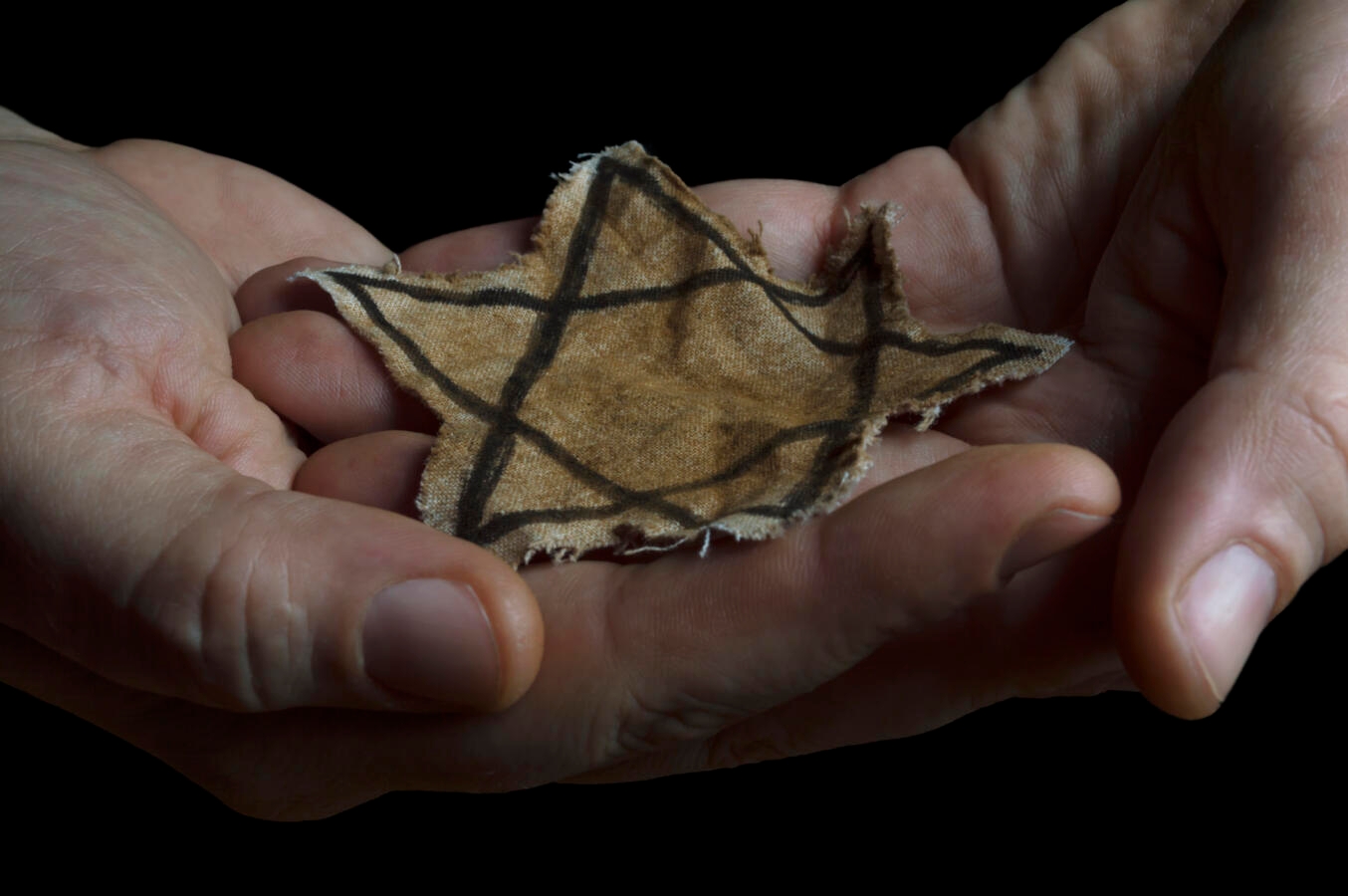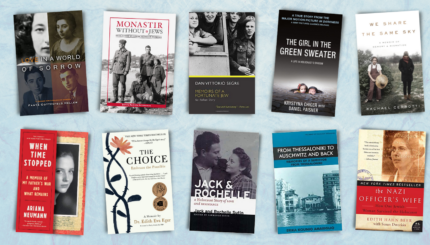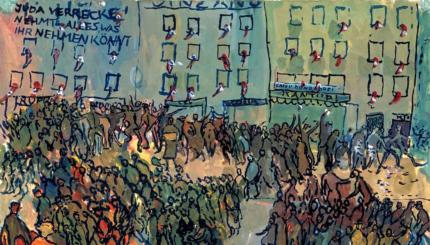Jewish history is replete with persecutions, but the systematic murder of two thirds of Europe’s Jews (6 million in total) in the Holocaust, or Shoah, altered Jews and Judaism forever. Since the end of World War II, Jewish communities have grappled with how and when to commemorate the Holocaust. As a result, just as there are many physical Holocaust memorials and museums around the world, there are many annual dates for memorializing this tragedy.
Yom Hashoah, 27th of Nisan (April or May)
Yom Hashoah, whose full name is Yom Hashoah V’HaGevurah, meaning the Day of the Holocaust and Heroism, is one of the more recent holidays added to the Jewish calendar. In many Jewish communities around the world, Yom Hashoah has become the primary Holocaust memorial day.
The Knesset, or Israeli parliament, passed the resolution creating Yom Hashoah in 1951. The 27th of Nisan was chosen because it loosely corresponded to the beginning of the Warsaw Ghetto Uprising on Erev Passover, the 14th of Nisan. However, because observing Yom Hashoah on that day would interfere with the preparations for Passover, it was not seriously considered as a potential national memorial day.
Many customs have become associated with the observance of Yom Hashoah in Israel. A two minute siren is heard twice during the day. Various ceremonies are held by schools and youth groups, and there is state ceremony at Yad VaShem, the Israeli Holocaust Memorial and Museum. Other rituals include hearing testimony from survivors, lighting memorial (yahrzeit) candles, reading the names of the deceased and wearing white.
With your help, My Jewish Learning can provide endless opportunities for learning, connection and discovery.
Not all Jewish communities in Israel observe Yom Hashoah. Some Orthodox and ultra-Orthodox communities do not mark Yom Hashoah in a significant way. This is in part because these communities do not recognize or condone the secular Zionist state that established the day, and also because there are more more traditional days for mourning (Tisha B’Av, for example) and ways to mourn (standing for a moment of silence, for instance, has no prior precedent in Jewish tradition). In addition, the month of Nisan, when the date occurs, is considered a month of happiness, not a time of mourning.
Since being added to the Jewish calendar in Israel, however, many Jewish communities across and beyond the denominational spectrum and around the world have started marking Yom Hashoah. Their observances look increasingly like Israeli observances. In North America, most synagogues and Jewish groups offer programming and events for Yom Hashoah which may include lighting yahrzeit candles and reading lists of names of victims.
Novemberpogrom/Kristallnacht, November 9th
Another date connected to Holocaust commemoration is the 9th of November. Known primarily as the Novemberpogrom (November Pogrom) in the German-speaking world, those within the English-speaking world typically know it as Kristallnacht: Night of the Broken Glass.
On the night of November 9, 1938, Nazi leadership as well as civilians attacked synagogues and Jewish institutional buildings, as well as businesses and even private property across what is today Germany and Austria. Some 30,000 Jewish men were brought to concentration camps, in what is widely understood to be the first mass imprisonment of Jews in the camp system.
The anniversary of the November Pogrom has become another Holocaust memorial day, though not as universally observed as Yom Hashoah. In Germany and Austria, both non-Jewish and Jewish ceremonies and events mark this date. These ceremonies often feature commemoration wreaths, Jewish prayers honoring the dead such as Mourners’ Kaddish or El Maleh Rahamim and survivors sharing their experiences (or the reading of eye-witness testimonies).
Outside of Germany and Austria, the 9th of November is primarily observed by those whose families fled Nazi Germany and Nazi-occupied Austria. Many of these descendants live in North America or Israel. Customs include lighting a yahrzeit candle and sharing stories of the family members who lived through the November Pogrom. Some synagogues, particularly those founded by Yekkes, or German Jews, will host events or lectures commemorating the destruction and impact of the November Pogrom.
Tisha B’Av, 9th of Av (Falls in July/August)
Tisha B’Av (literally: Ninth of Av) commemorates the destruction of the First Temple (586 BCE) and the Second Temple (70 CE) in Jerusalem. But even since talmudic times, it has been an occasion to mourn other tragedies that have befallen the Jews, like the Bar Kochba Revolt and the Crusades. In many cases, these tragedies are also ascribed to the Ninth of Av. Additionally, some tragedies added to the Ninth of Av didn’t occur on the 9th itself, but in the days surrounding it.
The most recent tragedy that has joined the events remembered on this day is the Holocaust. One calendar date used to connect the Ninth of Av to the Holocaust is the start of World War I on July 28, 1914 (which was, in that year, the 5th of Av). According to this understanding, World War I led to World War II and the Holocaust.
Tisha B’Av is one of Judaism’s two major fast days, the other being Yom Kippur. The book of Lamentations, or Eicha, is read in synagogues and sections of Jewish texts about destruction are studied. Many also have a custom to visit cemeteries.
For a long time, Tisha B’Av was not observed by most Reform communities, though that has begun to change. But for liberal Jews in general, Tisha B’Av is not seen as the main Holocaust memorial day, since Yom Hashoah serves that function in those communities.
By contrast, in many Orthodox and ultra-Orthodox Jewish communities, Tisha B’Av is the primary Holocaust memorial day. One reason for this is the religious, rather than secular, origins of the day. Another is that already in the time of the Talmud, Tisha B’Av became known as a day to observe various tragedies experienced by the Jewish people. Because of this, adding the Holocaust to the list of tragedies mourned on this date is in step with tradition.
Holocaust remembrance on Tisha B’Av is limited to Jewish communities. It is uncommon to have non-Jewish memorial activities on this day.
Tenth of Tevet (December or January)
The Tenth of Tevet is a minor fast day in Judaism that falls in late December or early January, and it marks the start of the Babylonian siege in Jerusalem in 588 BCE, which then led to the First Temple’s destruction.
Following World War II, the Orthodox Rabbinate in Israel began to mark the events of the Shoah on this date too. Rather than establish a new fast day, remembrance of the Holocaust was added to this minor fast day that marks what could have been, but was not, the end of the Jewish people. Mourner’s Kaddish is recited on this day for those whose place or date of death is unknown and those without living relatives.
As a day of Holocaust commemoration, the Tenth of Tevet is primarily observed in Orthodox communities, especially those in Israel. However, it has begun to also be observed by some Orthodox communities elsewhere due to the influence of Jewish thought from Israel. It is not known as a Holocaust memorial date in Reform and Conservative communities, nor among non-Jews.
International Holocaust Memorial Day, January 27th
On January 27th, 1945, the Soviet military liberated the Auschwitz-Birkenau concentration camp complex, and it was thereafter observed as memorial day for the Holocaust in various European countries. In 2005, 60 years after that liberation, the United Nations voted to designate it as International Holocaust Remembrance Day.
International Holocaust Memorial Day is not particular to Jews, and many non-Jews take this day to remember the Holocaust and its victims. Countries around the world, including Germany and Israel, host ceremonies that honor survivors and their descendants, feature discussions on the impact of antisemitism today, and listen to recitations of Mourner’s Kaddish or El Maleh Rahamim.
Some Jewish communities, particularly in Reform and Conservative circles, mark this memorial day, though it is generally less observed than other dates. A common Jewish critique of International Holocaust Memorial Day is that the observances on this date are too impersonal due to the ritualistic nature of many commemoration ceremonies and a tendency to generalize rather than focus on individual lives. In addition, a common critique is International Holocaust Remembrance Day lacks a significant connection to Judaism.



